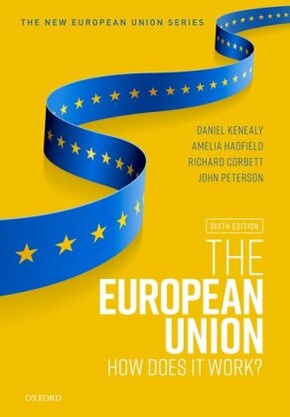The European Union - How does it work?
| Verlag | Oxford University Press |
| Auflage | 2022 |
| Seiten | 352 |
| Format | 17,4 x 1,5 x 24,7 cm |
| Print PDF | |
| Gewicht | 615 g |
| Artikeltyp | Englisches Buch |
| Reihe | New European Union Series |
| EAN | 9780198862246 |
| Bestell-Nr | 19886224EA |
As the most concise, accessible guide to the EU, The European Union: How does it work? is an ideal introduction for those coming to the subject for the first time. A team of expert scholars cut through the complexity to explain how the EU works, both in theory and in practice, helping students gain the knowledge they need to succeed.
The European Union: How does it work? is the perfect concise introduction to the EU's structure and operations for students coming to the subject for the first time. The sixth edition has been substantially updated to reflect a range of challenges confronting the EU. It incorporates expanded discussions of pressing policy challenges, including migration, climate change, the future of the EU-UK relationship after Brexit, and the erosion of democratic principles in some EU member states. It also offers expanded coverage of the EU-US relationship, the shifting global balance of power, and the impact on the EU of the rise of China and a fragmenting global economy.
The sixth edition sees the arrival of two new authors, Ramona Coman and Dionyssis G. Dimitrakopoulos - contributing Chapter 4 on member states and Chapter 7 on internal policies, respectively - and a new editor, Amelia Hadfield.
Learning features throughout the text help to develop students' understanding of t he EU. 'How it really works' boxes demonstrate the working of the EU in practice, and challenge students to contrast this with theoretical perspectives. 'Key terms and concepts' boxes provide concise definitions or summaries of words and ideas that are essential to understanding the EU. Furthermore, each chapter contains boxes exploring specific cases that highlight how the EU works, what it does, or how it has evolved. Taken together, these features encourage students to think laterally and critically about the reality of politics in the European Union.
Digital formats and resources
The sixth edition is available for students and institutions to purchase in a variety of formats.
The e-book offers a mobile experience and convenient access, along with functionality tools, navigation features, and links that offer extra learning support: www.oxfordtextbooks.co.uk/ebooks
In addition to supportive learning features within the book, the text is acco mpanied by online resources designed to help students to take their learning further.
For students:
- Test your understanding and receive instant feedback with a range of multiple-choice questions
- Revise key terms and test your knowledge of terminology from the book with our flashcard glossary
For registered adopters of the text:
- Guide class debate with suggested seminar questions and activities
- Adapt PowerPoint slides as a basis for lecture presentations, or use as handouts in class
Inhaltsverzeichnis:
Part I: Background
1: Daniel Kenealy, Amelia Hadfield, and Richard Corbett: Introduction
2: Desmond Dinan: How did we get here?
Part II: The EU: How does it work?
3: Richard Corbett, Daniel Kenealy, and Amelia Hadfield: The EU's Institutions
4: Ramona Coman: EU Member States
5: Daniel Kenealy: Policy-making in the EU
6: Richard Corbett: Democracy in the EU
Part III: The EU: What does it do?
7: Dionyssis G. Dimitrakopoulos: The EU's Internal Policies
8: Niklas Helwig: The EU as a Global Actor
9: Ulrich Sedelmeier: EU Enlargement and Wider Europe
Part IV: The EU: Where is it going?
10: Amelia Hadfield, Daniel Kenealy, and Richard Corbett: Future Challenges
11: Amelia Hadfield, Daniel Kenealy, and Richard Corbett: Conclusion

